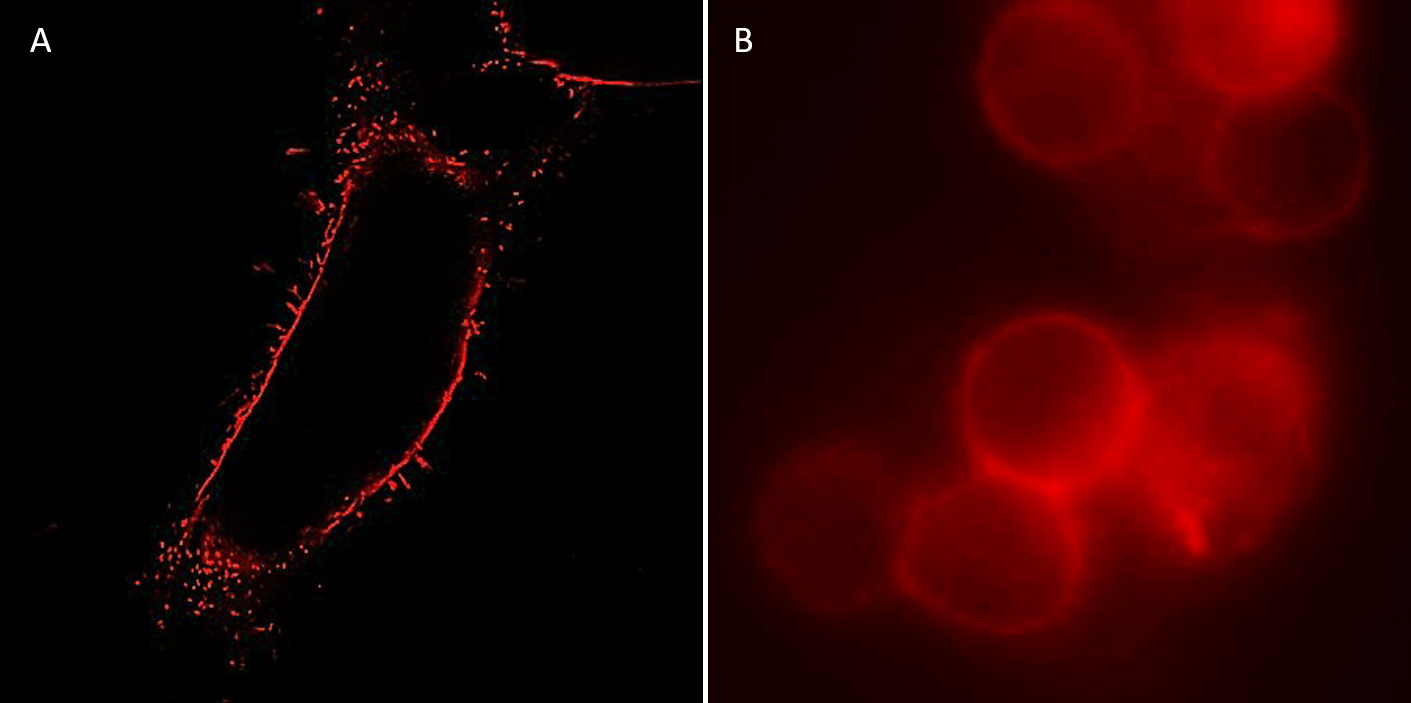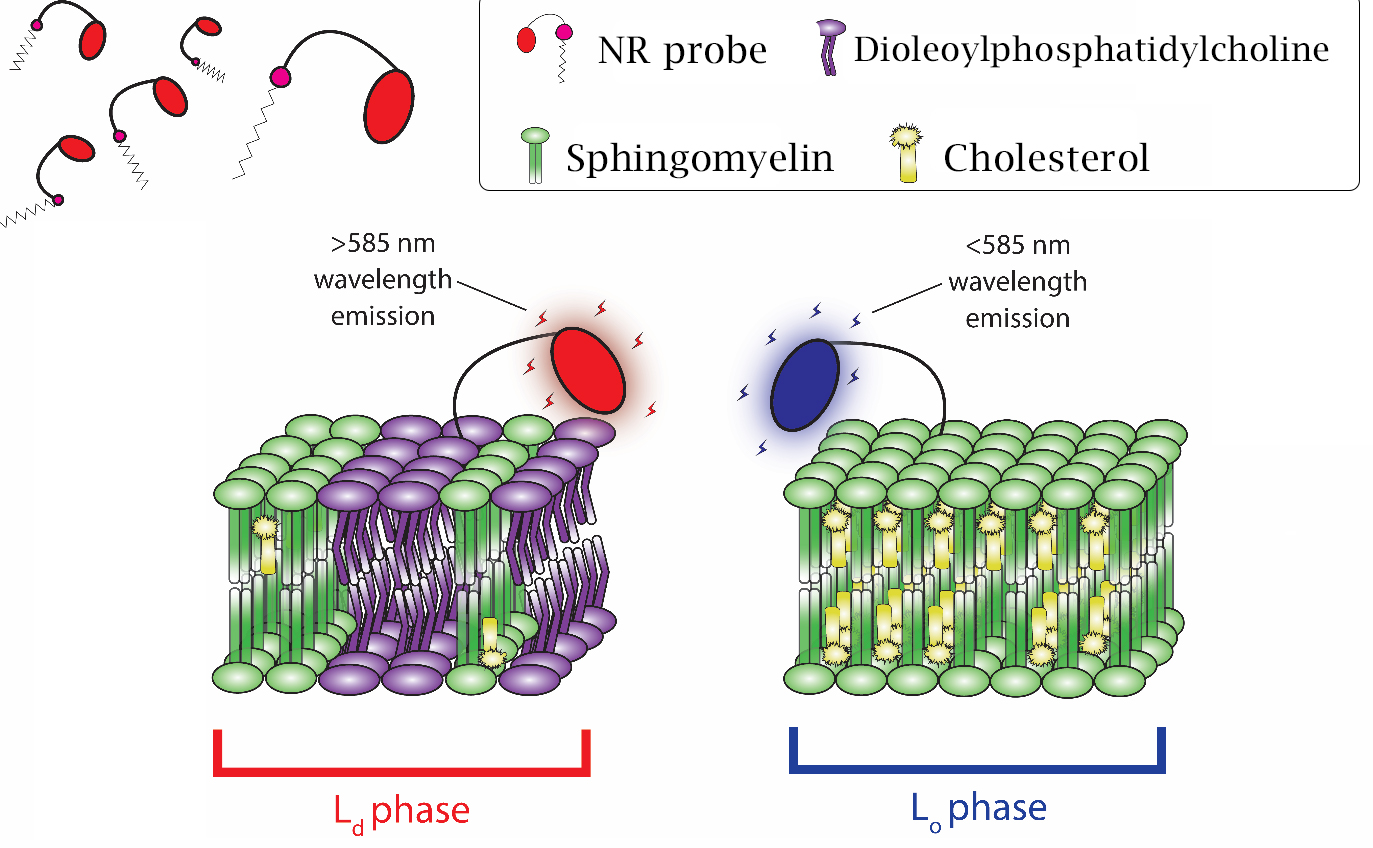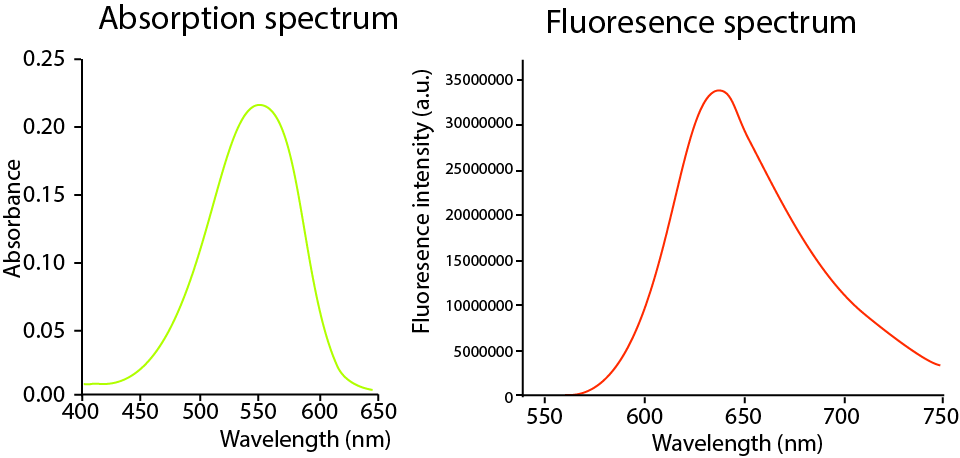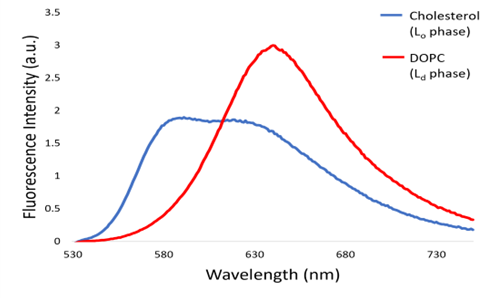MemGlow NR4A is a solvatochromic photostable plasma membrane-targeting dye with on/off switching that has been optimized for Super Resolution Point Accumulation for Imaging in Nanoscale Topography (SR-PAINT). Upon binding with a plasma membrane in a predominant liquid ordered (LO) phase NR4A exhibits a 45-50 nm wavelength shift relative to liquid disordered (Ld) phase enabling investigators to examine the nanoscale distribution of local chemical polarity in plasma membranes.
NR4A Membrane Polarity Probe Product Functions (MG06)
- The NR4A Membrane Polarity Probe is the first probe that enables nanoscale cartography of the lipid order exclusively at the surface of live cells.
- The NR4A Membrane Polarity Probe reveals nanoscopic protrusions and invaginations of lower Lipid Order in Plasma Membranes
- High Specificity helps unveil rich nanoscale structural features of the plasma membrane
- Weak Binders allow for better tracking of turn on events thanks to continuous flow exchange between the probe and membrane
For more detailed information on using this product see the About Tab
** 2 nmol of MemGlow will produce a 20µM stock solution when reconstituted with 100 µl of anhydrous DMSO

Figure 3. A) Super resolution imaging of live HeLa cells labeled with 10 nM NR4A (false colored red). B) Widefield fluorescent imaging of live HeLa S1 cells labeled with 10 nM NR4A. HeLa S1 cells were imaged with a TRITC filter set, a digital CCD camera, and 100x oil objective (false colored red).
Material
The absorption max of NR4A is 554 nm, with an emission spectra of 638 nm, an extinction coefficient of 45,000 M-1.cm-1 , and can be visualized using a Cy 3.5 filter set or other suitable filter sets. NR4A is supplied as a lyophilized pellet. NR4A is a lipid binding dye and appropriate PPE should be worn at all times. Dispose of NR4A according to local regulations and policies.
Storage and Reconstitution
The lyophilized product is stable at 4°C (<10% humidity) for 6 months and should be protected from light. To reconstitute, briefly centrifuge to collect the product at the bottom of the tube. NR4A should be reconstituted with 100 µl of anhydrous DMSO to create a 20 µM stock solution for cell imaging. After reconstitution the solution should be stored at -20°C where it is stable for 3 months. Once reconstituted, allow product to warm to room temperature before opening tube.
Important Technical Notes
-
- NR4A was purpose-engineered for super resolution techniques. It is not intended for use in conventional microscopy; however, it can be used with good results.
- Diluted solutions of NR4A in aqueous media should be used as soon as possible as it may precipitate.
- Serum and proteins will reduce NR4A staining efficiency. When possible NR4A staining should take place in the absence of serum. Optimally, the imaging cell media is serum-free media or reduced serum media, or PBS.
- NR4A is generally non-toxic to live cells but morphological changes 12 hours after no-wash applications can cause cell shrinkage. For repeated imaging follow cell labeling we do not recommend washing cells due to the weak binding properties of the NR4A probe; however, optimization of probe concentration for longer studies may be required.
- NR4A will work with a range of concentrations. Investigators should empirically determine the best concentration for their application. An initial concentration range of 20-200 nM is recommended.
- NR4A was designed for SR-PAINT applications as such it is intended to have a weaker binding affinity to the plasma membrane (approx. 10x lower) than NR12A.
Note. Optimal conditions for efficient labeling should be determined for each cell line and application.
Reagents
- NR4A (Cat. # MG06).
- Semi-confluent HEK293 cells grown in a chamber slide.
- Imaging medias: PBS, serum-free media or reduced serum media.
Equipment
- Fluorescent microscope with a Cy 3.5 excitation filter at 553 +/-20 nm and emission filter at 637 +/-20 nm for NR4A.
- Digital camera.
Method
- Cells should be seeded onto imaging-appropriate glass or plastics and grown according to cell line requirements to semi-confluency.
- Remove any cell culture media from your cells and replace with the media used for imaging (e.g., serum-free media). Do not allow the cells to dry.
- Prepare the probe solution by diluting 5 µl of 20 µM MemGlow NR4A stock in 1 mL imaging media to create a 100 nM working solution and mix thoroughly. Work quickly as the probes will begin to aggregate over time reducing labeling efficiency.
- Replace the cell media, as added in step 2, with diluted probe solution ensuring cells are submerged. Incubate cells in MemGlow™ solution for 10 minutes at room temperature.
- For SR-Paint applications the cells are ready to image. For general microscopy applications no washing step is required prior to imaging, but can be performed if desired with imaging media.
Product Citations
- Kucherak, O. A. et al. Switchable nile red-based probe for cholesterol and lipid order at the outer leaflet of biomembranes. J. Am. Chem. Soc. 132, 4907–4916 (2010).
- Danylchuk, D. I., Moon, S., Xu, K. & Klymchenko, A. S. Switchable Solvatochromic Probes for Live-Cell Super-resolution Imaging of Plasma Membrane Organization. Angew. Chemie - Int. Ed. 58, 14920–14924 (2019).
MEMBRIGHT™ is a trademark of CNRS/UNISTRA of France.



